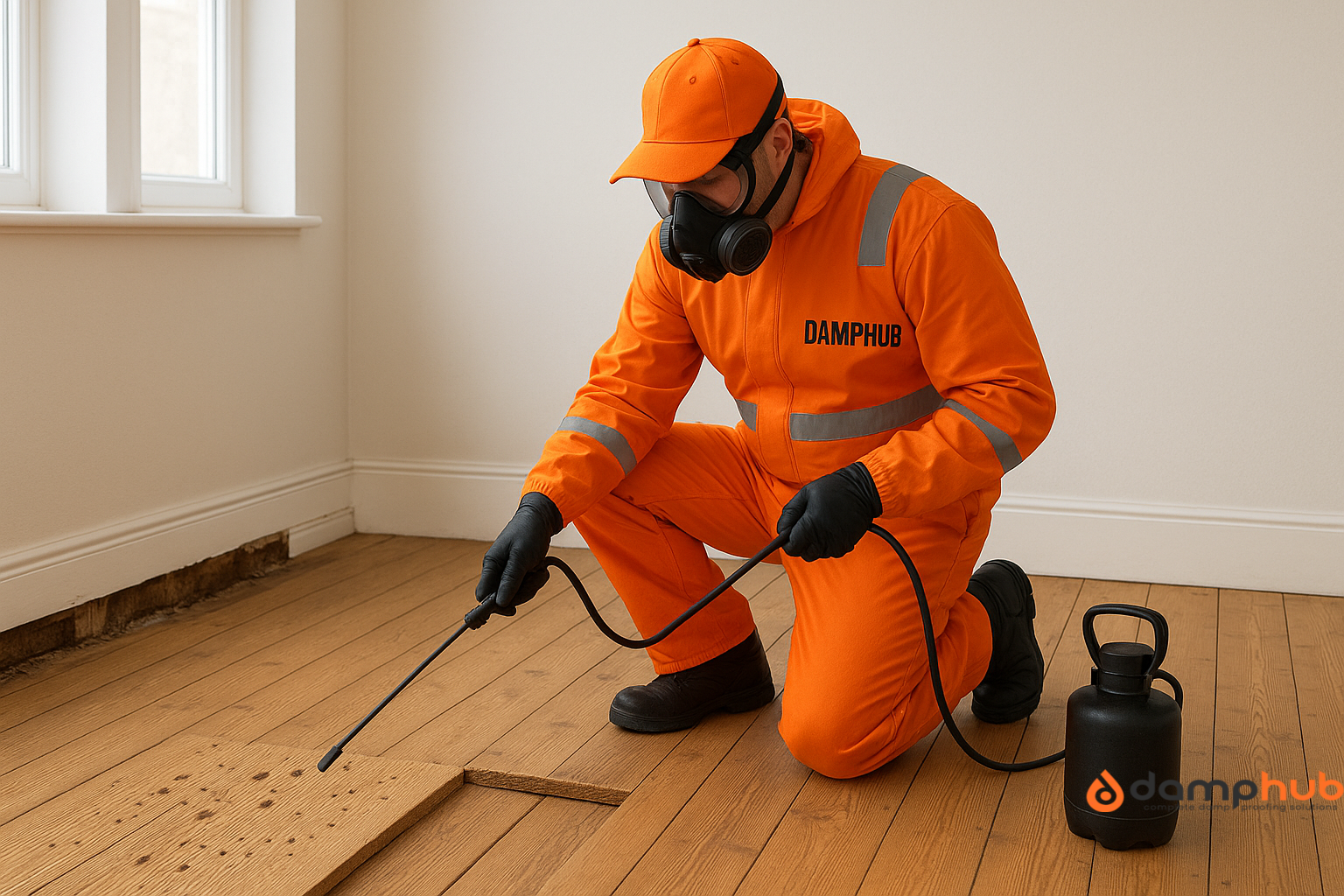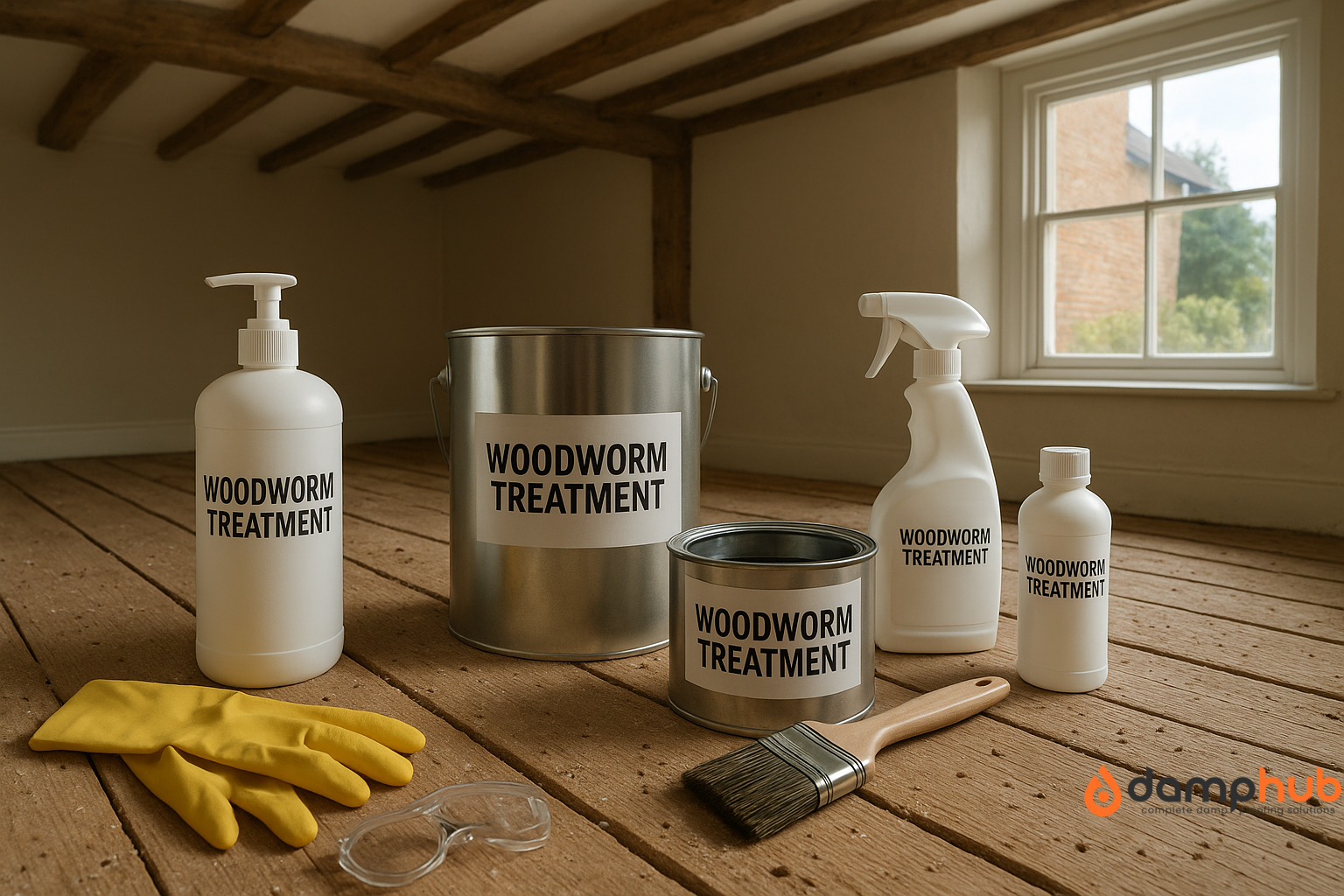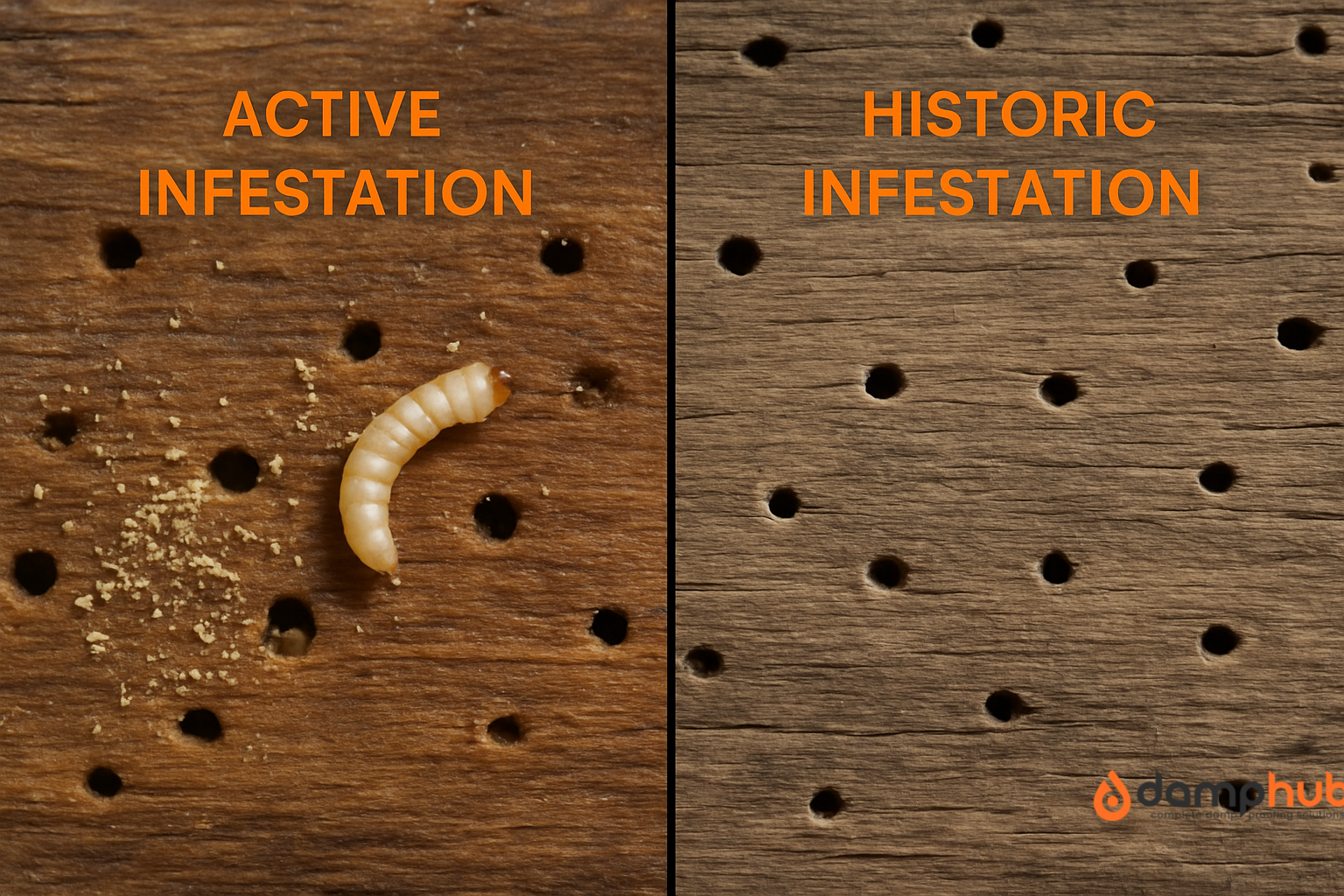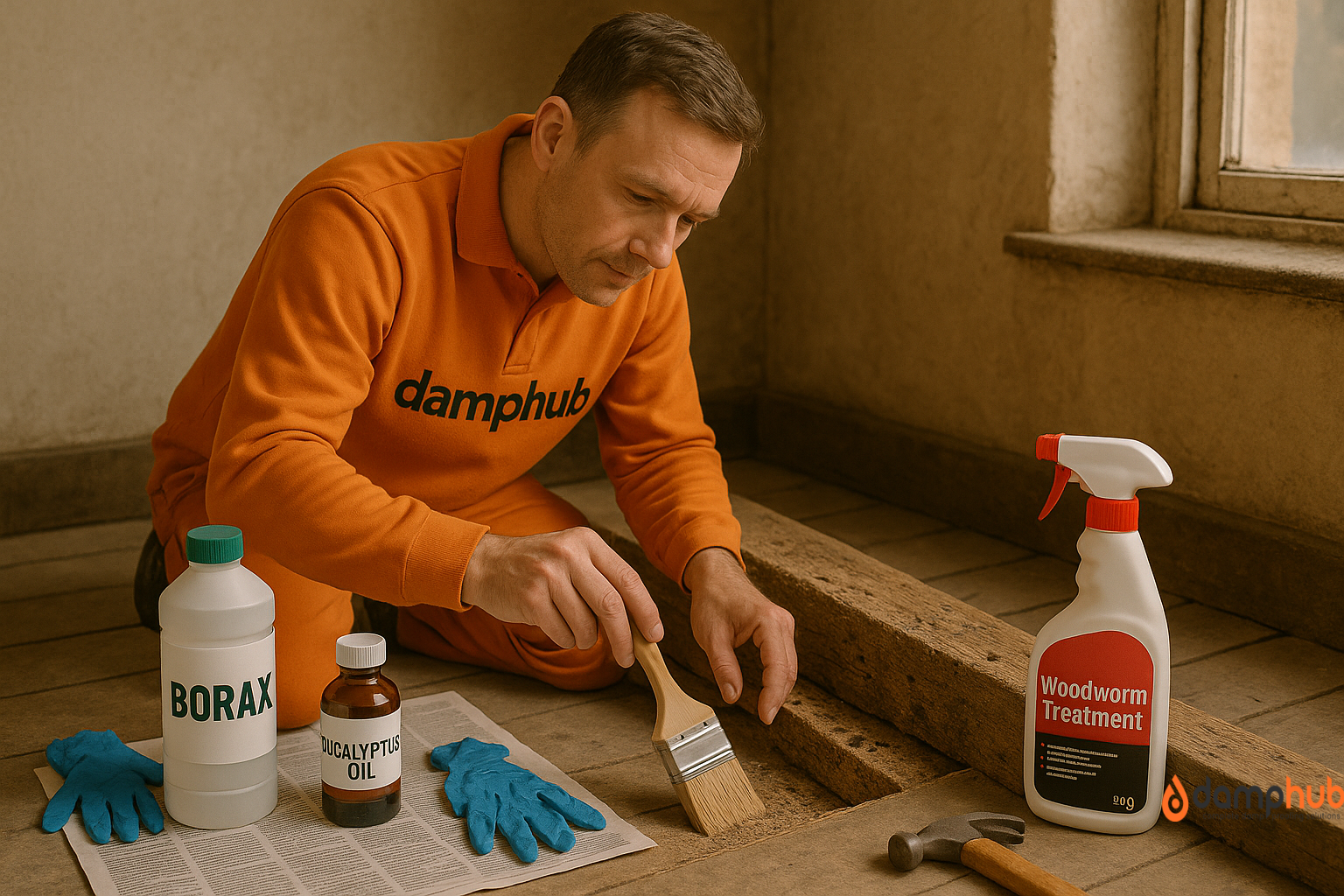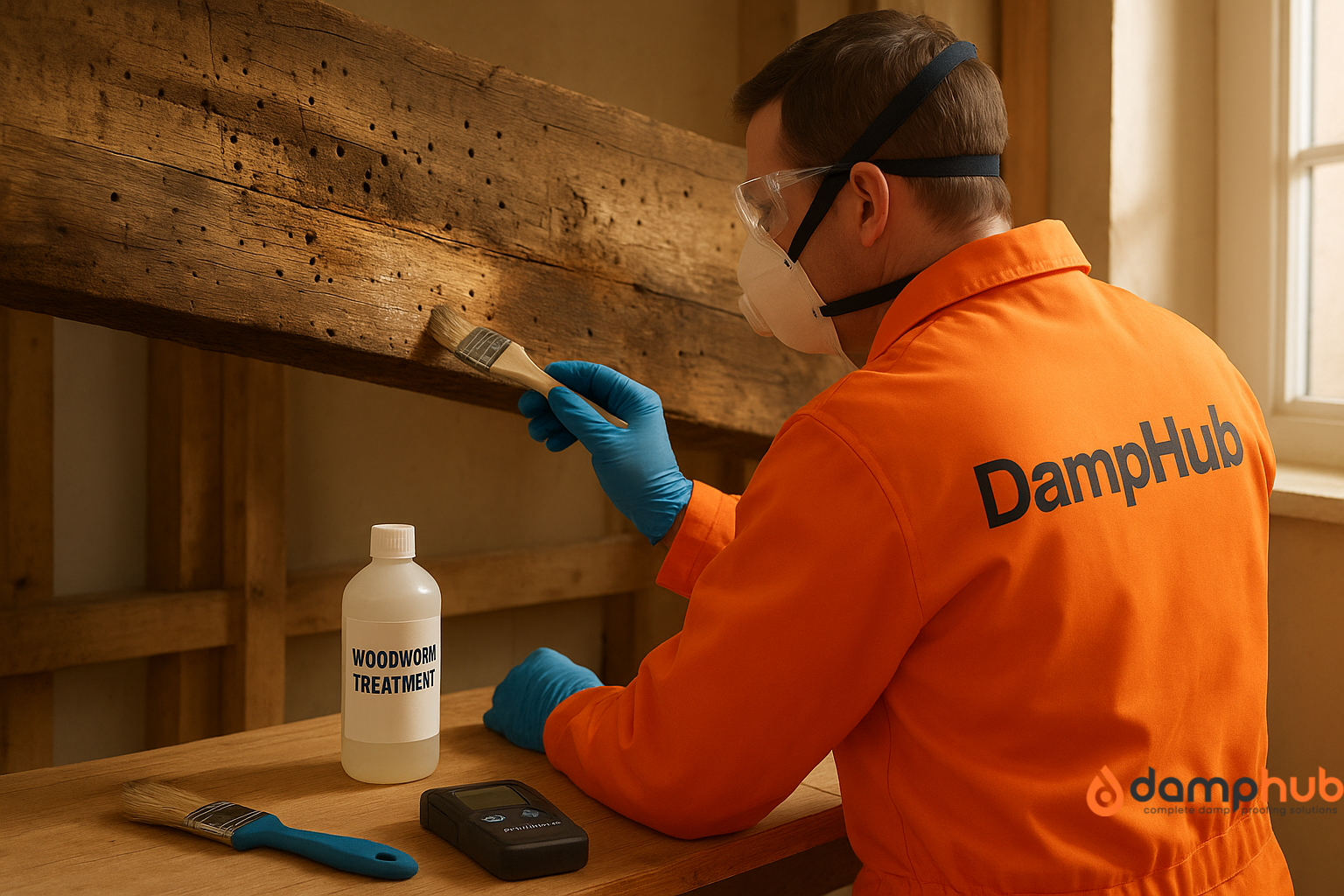
Quick Takeaways
- Woodworm isn’t a worm – it’s the larval stage of beetles that burrow through timber.
- Most common in the UK is the Common Furniture Beetle, which creates 1–2mm holes and fine powdery dust.
- Larger beetles like the House Longhorn leave big oval holes (6–10mm) and do serious structural damage.
- Frass texture and hole size are the easiest clues to identify the beetle species.
- Professional help is vital for serious infestations, especially in structural timbers or historic buildings.
Woodworm is a term used to describe the larvae of several species of wood-boring beetles that feed on and tunnel through timber.
In the UK, woodworm infestations can damage everything from antique furniture to roof timbers.
But what does woodworm look like?
And how can you tell which type you’re dealing with?
Let’s break it down by first understanding the general signs of woodworm, followed by a detailed look at the most common species found in UK properties.
What Does a Woodworm Look Like in General?
Woodworm refers to the larval stage of wood-boring beetles.
The larvae themselves are small, creamy-white grubs with curved, segmented bodies and tiny brown heads.
They are usually 2–7mm long and are rarely seen unless the timber is broken open.
More commonly, you’ll spot evidence of their presence, which includes:
- Tiny round exit holes (1–2mm in diameter) on wood surfaces
- Fine, powdery dust (frass) around holes or beneath affected wood
- Tunnels (galleries) inside the wood if it is split or broken
- Crumbling edges, weakened floorboards or beams
- Adult beetles, particularly in warmer months
Read more here: 👉 How to Identify and Get Rid of Black Carpet Beetles
Types of Woodworm and What They Look Like
Different types of woodworm come from different species of beetles.
Each has unique features in terms of physical appearance, preferred habitat, and visible signs of infestation.
1. Common Furniture Beetle (Anobium punctatum)
The Common Furniture Beetle is the most widespread woodworm in the UK.
Its larvae are small, creamy-white, and C-shaped, measuring around 2–5mm long.
The adult beetle is brown, dome-shaped, and about 2.5–4.5mm in size.
It creates tiny round exit holes (1–2mm) and leaves behind fine, gritty frass.
It prefers softwoods like pine and is commonly found in floorboards, joists, loft timbers, and furniture, especially in damp or poorly ventilated areas.
Appearance (Larvae):
- Cream-coloured, C-shaped body with a darker head
- Around 2–5mm long
- Narrow, rigid body segments
Appearance (Adult Beetle):
- Brown, dome-shaped body
- 2.5–4.5mm long
- Fine hairs on the back, giving it a dusty look
Habitat:
- Prefers softwoods like pine and spruce
- Found in floorboards, joists, furniture, and loft timbers
How to Identify:
- Exit holes are 1–2mm in diameter
- Powdery frass may fall when tapping or disturbing the timber
- Common in damp, poorly ventilated areas

2. Deathwatch Beetle (Xestobium rufovillosum)
The Deathwatch Beetle is a wood-boring insect that primarily attacks damp, decaying hardwoods like oak and elm.
The larvae are up to 11mm long, creamy-white, and live deep inside timber for several years.
The adult beetle is brown and mottled, measuring 7–9mm, and is famous for its ticking sound during mating season.
You’ll typically find it in older, historic buildings with fungal decay. Look for larger exit holes (3–4mm) and coarse, gritty frass near timbers.
Appearance (Larvae):
- Up to 11mm long
- Creamy-white, wrinkled body with brown jaws
Appearance (Adult Beetle):
- Brown and oval-shaped with mottled patches
- 7–9mm in length
- Known for making a “ticking” sound during mating season
Habitat:
- Attacks hardwoods like oak and elm, particularly when decayed by fungal rot
- Found in historic buildings, churches, and older properties
How to Identify:
- Larger exit holes (3–4mm)
- Frass is coarse and sausage-shaped
- Most damage occurs deep inside beams, often not visible externally

3. House Longhorn Beetle (Hylotrupes bajulus)
Read more here: How to Prevent Carpet Beetle Infestation
The House Longhorn Beetle is one of the most destructive wood-boring insects found in the UK, though it’s primarily confined to southern England, especially Surrey.
The adult beetle is large (10–25mm), dark brown or black, with distinctive long antennae, often longer than its body, and white speckles on its wing cases.
Its larvae are cream-coloured, robust, and can grow up to 30mm, making deep tunnels in softwood timbers.
You’ll often find this beetle in roof timbers like pine, where it leaves behind large oval exit holes (6–10mm) and coarse, gritty frass.
Due to the severe structural damage it can cause, identifying and treating this woodworm promptly is critical.
(Mainly found in parts of southern England, especially Surrey)
Appearance (Larvae):
- Up to 30mm long
- Creamy-white with strong mandibles and prominent ridges on the body
Appearance (Adult Beetle):
- Black or dark brown with white/grey speckles
- 10–25mm in length
- Long antennae (often longer than the body)
Habitat:
- Targets softwoods, especially roofing timbers like pine
- Thrives in warmer environments (lofts, attics)
How to Identify:
- Large oval exit holes (6–10mm)
- Frass looks coarse, gritty, and contains wood fragments
- Structural weakening is often severe in advanced stages

4. Powderpost Beetle (Lyctus brunneus)
The Powderpost Beetle is a small but destructive wood-boring insect that primarily targets new hardwoods such as oak, ash, and mahogany, often within 10 years of being milled.
The adult beetle is slender, reddish-brown, and measures just 2–5mm long, with a narrow, elongated body that can squeeze into tiny cracks.
The larvae are equally small and hard to spot, typically about 1–2mm, making infestations difficult to detect in the early stages.
These beetles produce very fine, talcum-powder-like frass and tiny, 1mm exit holes, usually found in wooden floors, furniture, or kitchen units.
Though small, they can cause significant surface damage to new timber products if not treated quickly.
See our other guide: 👉 What Is Woolly Bear Carpet Beetle?
Appearance (Larvae):
- Around 1–2mm long
- Very slender and hard to spot
Appearance (Adult Beetle):
- Reddish-brown, narrow, and elongated body
- 2–5mm long
Habitat:
- Infests hardwoods like oak, ash, and mahogany
- Common in recently manufactured furniture or imported timber products
How to Identify:
- Very fine exit holes (1mm)
- Frass is very powdery, like talcum powder
- Affects newer timbers less than 10 years old

Final Tips for Identification
- Time of Year Matters: Adult beetles usually emerge from wood between April and September, which is when you’re most likely to spot them or find fresh exit holes.
- Check for Activity: Fresh frass, beetles, or damp conditions may suggest an active woodworm infestation, while older exit holes could be historic and inactive.
- Use a magnifying glass to examine hole size, frass texture, and beetle features more closely.
- Don’t Rely on One Sign: Use a combination of clues (exit holes, frass, structural damage, and beetle sightings) for accurate identification.
When to Call a Professional
If you spot signs of woodworm and are unsure about the extent of the damage or the species involved, it’s best to consult a professional.
Misidentifying a species like the House Longhorn Beetle could lead to severe structural risk if left untreated.
You can find certified timber pest specialists through the Property Care Association (PCA)
Woodworm Comparison Table (UK)
| Woodworm Type | Larvae | Adult Beetle | Timber | Habitat |
|---|---|---|---|---|
| Common Furniture Beetle (Anobium punctatum) |
Curved, 2–5mm Creamy-white |
Brown, 2.5–4.5mm Dome shape |
Softwoods | Furniture, floorboards |
| Deathwatch Beetle (Xestobium rufovillosum) |
Wrinkled, up to 11mm | Reddish, 2–5mm Elongated |
Old hardwoods | Rotting beams |
| House Longhorn Beetle (Hylotrupes bajulus) |
Large, 30mm Strong jaws |
Dark, 10–25mm Speckled |
Roof timbers | Lofts (S. England) |
| Powderpost Beetle (Lyctus brunneus) |
Slender, 1–2mm | Mottled, 7–9mm Oval |
New hardwoods | Floors, furniture |
Quick Recaps
- Woodworm larvae are creamy-white grubs, usually hidden deep in the timber.
- Look for exit holes, frass (wood dust), weakened wood, and possible beetle sightings (April–September).
- Deathwatch Beetles prefer damp hardwoods and are known for their ticking sound.
- Powderpost Beetles attack newer hardwoods and leave talcum-like dust and tiny 1mm holes.
- Left untreated, woodworm does not go away – it can slowly weaken floors, beams, and furniture over years.
What Does Woodworm Look Like? Questions Answered

-
How do you know if you have woodworm?
You can identify woodworm by looking for these key signs:
– Tiny exit holes (1-2mm wide) in timber, often with ragged edges
– Fresh, powdery wood dust (frass) near or under the holes
– Tunnels within the wood, revealed when the timber is cut open or broken
– Weak or crumbly wood, especially around edges or under paint
– Live larvae or adult beetles, though sightings are rare -
What causes woodworm in a house?
Woodworm is caused by beetle larvae, most commonly from the Common Furniture Beetle (Anobium punctatum), infesting timber.
Conditions that encourage infestation include:
– Damp or poorly ventilated environments
– Untreated or old timber
– Timber in contact with masonry, where moisture can wick in -
How do you get rid of woodworm?
Woodworm treatment involves:
– Professional assessment to identify the beetle species and extent
– Applying a specialist woodworm treatment spray or gel
– Replacing severely damaged timbers
– Improving ventilation and reducing moisture to prevent reinfestationMild infestations can often be managed with DIY woodworm treatment products, but more serious cases require professional intervention.
-
Does woodworm go away on its own?
No. Woodworm does not typically go away by itself. The larvae may emerge, leaving behind dormant timber, but unless treated, the cycle can repeat — especially if conditions remain favourable.
-
How long does woodworm take to come out?
The woodworm life cycle spans:
– 2 to 5 years in the larval (wood-eating) stage
– Followed by adult emergence, usually in spring or early summerSo damage can continue for years before any signs appear.
-
Is there a spray for woodworm?
Yes. There are various woodworm treatment sprays available in hardware stores and from specialist contractors. These sprays:
– Kill larvae and adult beetles
– Are usually solvent- or water-based insecticides
– Should be applied to bare, clean woodAlways follow safety instructions or hire a professional if you’re unsure.
-
How difficult is it to treat woodworm?
Treatment difficulty depends on:
– Extent of the infestation
– Accessibility of affected timber
– Type of beetle involvedSmall, isolated infestations are straightforward to treat. Severe or structural infestations may require timber replacement, fumigation, or major remedial works.
-
Is woodworm harmful to humans?
Not directly. Woodworm beetles do not bite or sting humans, and they don’t carry disease. However, the structural damage they cause can pose indirect safety risks, especially if they affect floors, beams, or joists.
-
Does woodworm spread fast?
Woodworm doesn’t spread rapidly, but over time, it can infest other untreated or damp timbers nearby. A single beetle can lay up to 50 eggs, and repeated generations can lead to widespread damage if unchecked.
-
What happens if you don’t treat woodworm?
Untreated woodworm can result in:
– Progressive weakening of timber
– Compromised structural integrity
– Costly repairs or replacements
– Ongoing infestation cyclesIf you’re buying or selling a property, visible woodworm may also impact valuation or require proof of treatment.
-
How much does woodworm treatment costs?
Woodworm treatment prices typically range from around £150 for small jobs to over £1,500 for larger infestations. Keep in mind, this covers only the treatment—not any repair work afterward. For a complete breakdown of costs, factors, and money-saving tips, check out our detailed guide: Woodworm Treatment Costs Explained.

